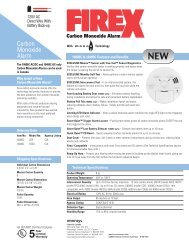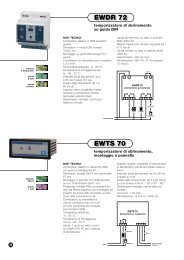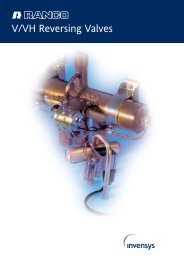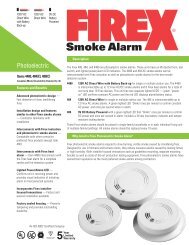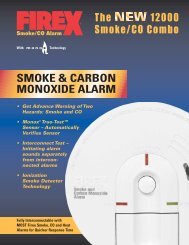SMOKE/CARBON MONOXIDE ALARM MODEL FADCQ - FireX
SMOKE/CARBON MONOXIDE ALARM MODEL FADCQ - FireX
SMOKE/CARBON MONOXIDE ALARM MODEL FADCQ - FireX
Create successful ePaper yourself
Turn your PDF publications into a flip-book with our unique Google optimized e-Paper software.
Conditions That Can Cause CO Levels to Change<br />
The following conditions can result in transient<br />
CO situations in the home.<br />
1. Excessive spillage or reverse venting of fuel<br />
burning appliances caused by outdoor<br />
ambient conditions, such as:<br />
a. Wind direction and/or velocity, including<br />
high gusts of wind. Heavy air in the vent<br />
pipes (cold/humid air with extended<br />
periods between cycles).<br />
b. Negative pressure differential resulting<br />
from the use of exhaust fans.<br />
c. Simultaneous operation of several fuel<br />
burning appliances competing for limited<br />
internal air.<br />
Limitations of This Smoke/CO Alarm<br />
• Smoke and CO alarms may not alert every<br />
household member every time. The alarm horn is<br />
loud in order to alert individuals to a potential<br />
danger. However, there may be limiting circumstances<br />
where a household member may not<br />
hear the alarm (e.g. outdoor or indoor noise,<br />
sound sleepers, drug or alcohol usage, the hard<br />
of hearing, etc.). If you suspect that this alarm<br />
may not alert a household member, install and<br />
maintain specialty smoke alarms. Household<br />
members must hear the alarm’s warning sound<br />
and quickly respond to it to reduce the risk of<br />
damage, injury, or death that may result from<br />
fire. If a household member is hard of hearing,<br />
install special alarms with lights or vibrating<br />
devices to alert occupants.<br />
• Smoke alarms can sound their alarms only when<br />
they detect smoke. Smoke alarms detect combustion<br />
particles in the air. They do not sense<br />
heat, flame, or gas. This alarm is designed to<br />
give audible warning of a developing fire.<br />
25<br />
d. Vent pipe connections vibrating loose<br />
from clothes dryers, furnaces, or water<br />
heaters.<br />
e. Obstruction in the vent pipe or unconventional<br />
vent pipe designs which can<br />
amplify the above situations.<br />
2. Extended operation of unvented fuel burning<br />
devices (range, oven, fireplace, etc.).<br />
3. Temperature inversions which can trap<br />
exhaust gasses near the ground.<br />
4. Car idling in an open or closed attached<br />
garage, or near a home.<br />
However, many fires are fast-burning, explosive,<br />
or intentional. Others are caused by carelessness<br />
or safety hazards. Smoke may not reach<br />
the smoke alarm QUICKLY ENOUGH to ensure<br />
safe escape.<br />
• CO alarms can sound their alarms only when<br />
they detect CO gas. They do not sense heat,<br />
flame, or any gas other than carbon monoxide<br />
(CO). This alarm is designed to give audible<br />
warning that a dangerously high level of CO is<br />
present. You must respond immediately to the<br />
CO alarm horn.<br />
• Smoke and CO alarms have limitations. This<br />
alarm is not foolproof and is not warranted to<br />
protect lives or property from fire. Smoke and<br />
CO alarms are not a substitute for insurance.<br />
Homeowners and renters should insure their<br />
lives and property. In addition, it is possible for<br />
the alarm to fail at any time. For this reason,<br />
you must test the alarm weekly and replace<br />
every 5 years.



